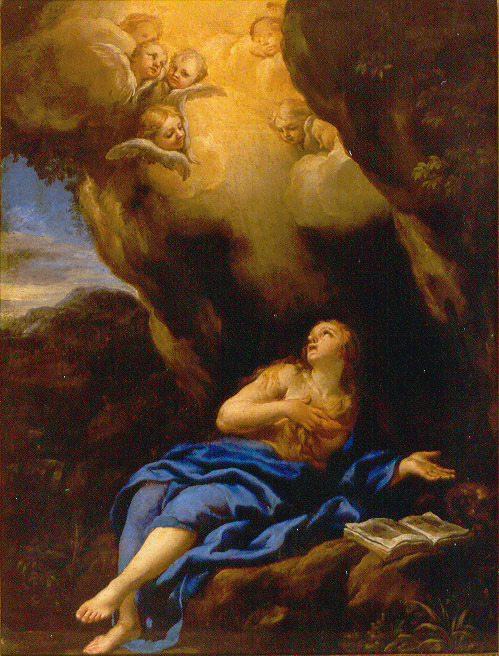In the cultural imagination of the Western world, few figures evoke as much fascination and mystery as Mary Magdalene. Traditionally called the “apostle to the apostles” and described as an early witness to the resurrection, her image has undergone profound transformations over the centuries. From the canonical gospels to medieval legends, from oral traditions to sacred art, Mary Magdalene has come to symbolize redemption, profound spirituality, and a form of feminine strength that challenges conventional archetypes.
According to an enduring Provençal tradition, shortly after the resurrection, a group of Jesus’ followers were cast adrift from the Holy Land in a rudderless, sail-less boat. Among them were Mary Magdalene, her sisters Mary Salome and Mary Jacobe, her brother Lazarus, Martha, Maximinus, and the enigmatic figure of Sarah the Egyptian. Guided by the currents, they reached the mouth of the Rhône River, in what is now the Camargue region of France, disembarking at the present-day town of Saintes-Maries-de-la-Mer.
Though absent from canonical scripture, this legend has been deeply rooted in the collective memory of southern France since at least the 11th century CE. It nourished a unique devotional culture centered around Mary Magdalene, known as the Magdalene cult, whose spiritual geography is anchored in Provence.
A Saint Between History and Myth

Local tradition holds that after reaching the coast, Mary Magdalene withdrew into the mountains of Sainte-Baume, living her final years in solitude, penance, and contemplation. She is said to have been sustained by angels, choosing a life of retreat after having preached across parts of Gaul.
Throughout the Middle Ages, her figure evolved. While the gospels portray her primarily as a devoted follower of Jesus, Western tradition increasingly identified her with the unnamed penitent woman who anoints Christ’s feet. This merging of narratives forged a powerful image: the redeemed woman who achieves spiritual elevation through repentance and contemplation, becoming an emblem of penitence and inner grace.
This imagery was institutionalized in the 13th century CE, when relics discovered in Saint-Maximin-la-Sainte-Baume were attributed to Mary Magdalene. Under the patronage of Charles II of Anjou, a monumental Gothic basilica was constructed to house her sarcophagus. Chronicles of the discovery speak of miraculous signs: a sweet fragrance filling the crypt and a branch growing from her incorrupt tongue, interpreted as a symbol of spiritual fertility.
The Way of Mary Magdalene: A Journey Through Land and Spirit
Inspired by this layered tradition, the Chemin de Marie-Madeleine (Way of Mary Magdalene) traces the places associated with her legendary passage through Provence. It offers not only a physical route but a path of interior transformation. From the sea to the mountains, each stage represents a symbolic movement: water as baptism and exile; earth as mission and testimony; stone as retreat and revelation.
Stages of the Way
Saintes-Maries-de-la-Mer
The starting point of the journey and a symbol of faith’s landing. The fortified Church of Notre-Dame-de-la-Mer houses the relics of the “holy Maries” and of Saint Sarah, who is particularly venerated by the Romani community. Every May, vibrant sea processions draw thousands of pilgrims.
Arles
Once a Roman colony and an early center of Christianity in Gaul, Arles connects more with Lazarus and Martha than with Mary Magdalene herself. Its early Christian churches and historic atmosphere evoke the first spread of the Christian message in the region.
Tarascon
Known for devotion to Saint Martha, Mary Magdalene’s sister, celebrated for taming the legendary Tarasque creature through her faith. The Collegiate Church of Saint Martha preserves her relics, blending spiritual and symbolic dimensions.
Aix-en-Provence
Associated with Saint Maximinus, regarded as the region’s first bishop and a close companion of Mary Magdalene. He played a crucial role in organizing the early Christian communities of southern France.
Plan-d’Aups-Sainte-Baume
Situated at the foot of the Sainte-Baume massif, where the grotto attributed to Mary Magdalene’s hermitage is located. Ascending to the sanctuary offers a profound spiritual experience through the quiet of the forest and the steep stone paths.
Saint-Maximin-la-Sainte-Baume
The pilgrimage’s culmination. Here stands the grand Gothic basilica, sheltering the crypt and the sarcophagus associated with Mary Magdalene. It remains the liturgical heart of the Magdalene devotion and a place of reflection on her complex legacy.
Beyond Provence: Symbols and Echoes Across Europe
The Way of Mary Magdalene extends beyond Provence’s landscapes. Her cult flourished in Vézelay, Burgundy, making it a major pilgrimage destination during the Middle Ages. In Toulouse, her relics were once safeguarded before their relocation to Saint-Maximin. In Marseille, Lazarus is honored as her brother and the city’s first bishop. Across the English-speaking world, Mary Magdalene’s image evolved into a symbol of feminine wisdom and spiritual resilience.
Today, she is often seen as a figure of inclusive mysticism and hidden knowledge, a voice of early discipleship whose influence continues to inspire.
A Living Legacy in Dialogue With Europe
Today, the Way of Mary Magdalene is more than just a devotional route — it is a path of cultural dialogue between the past and the present. Its footsteps intersect with other spiritual journeys that span across Europe. In particular, due to Mary Magdalene’s profound connection with the Passion, Death, and Resurrection of Christ, her Way is envisioned as part of a future European Cultural Itinerary: The Way of the Holy Grail. This emerging network, still awaiting official recognition, links the main sites associated with the cup used by Christ at the Last Supper, weaving sacred history into the living heritage of communities across the continent
This route should begins in Rome and Naples, passes through Avignon—historic seat of the papacy in the 14th century CE—and reaches Valencia, where the Holy Chalice has been kept in the cathedral since the 15th century CE. Avignon’s role was pivotal: historical accounts from the 17th century describe how Pope Benedict XIII, known as the “Pope Luna,” facilitated the transfer of the relic to Aragona, allowing King Martin I to retrieve it from the Monastery of San Juan de la Peña in 1399. Respecting canonical prohibitions against the sale of relics established at the Second Lateran Council (1139 CE), the chalice was gifted rather than traded.
Without the Avignon papacy, this transference might never have occurred. Thus, Provence stands not only as a landscape of legend but also as a bridge in the transmission of sacred heritage across Europe.
Pilgrimage Toward the Essential
Walking the Chemin de Marie-Madeleine (Way of Mary Magdalene) today means engaging with a living tradition. It invites travelers to move between history and legend, between the tangible and the symbolic. It is a journey shaped by the echoes of a figure whose memory, across centuries and interpretations, continues to inspire quests for inner discovery, reconciliation, and beauty.
From the murmurs of the Mediterranean to the silence of the grotto, this path opens a profound dialogue with Europe’s spiritual roots—where memory, landscape, and human search converge at every step.
This content comes to you in collaboration with The Way of the Holy Grail, Route of Knowledge, Way of Peace




